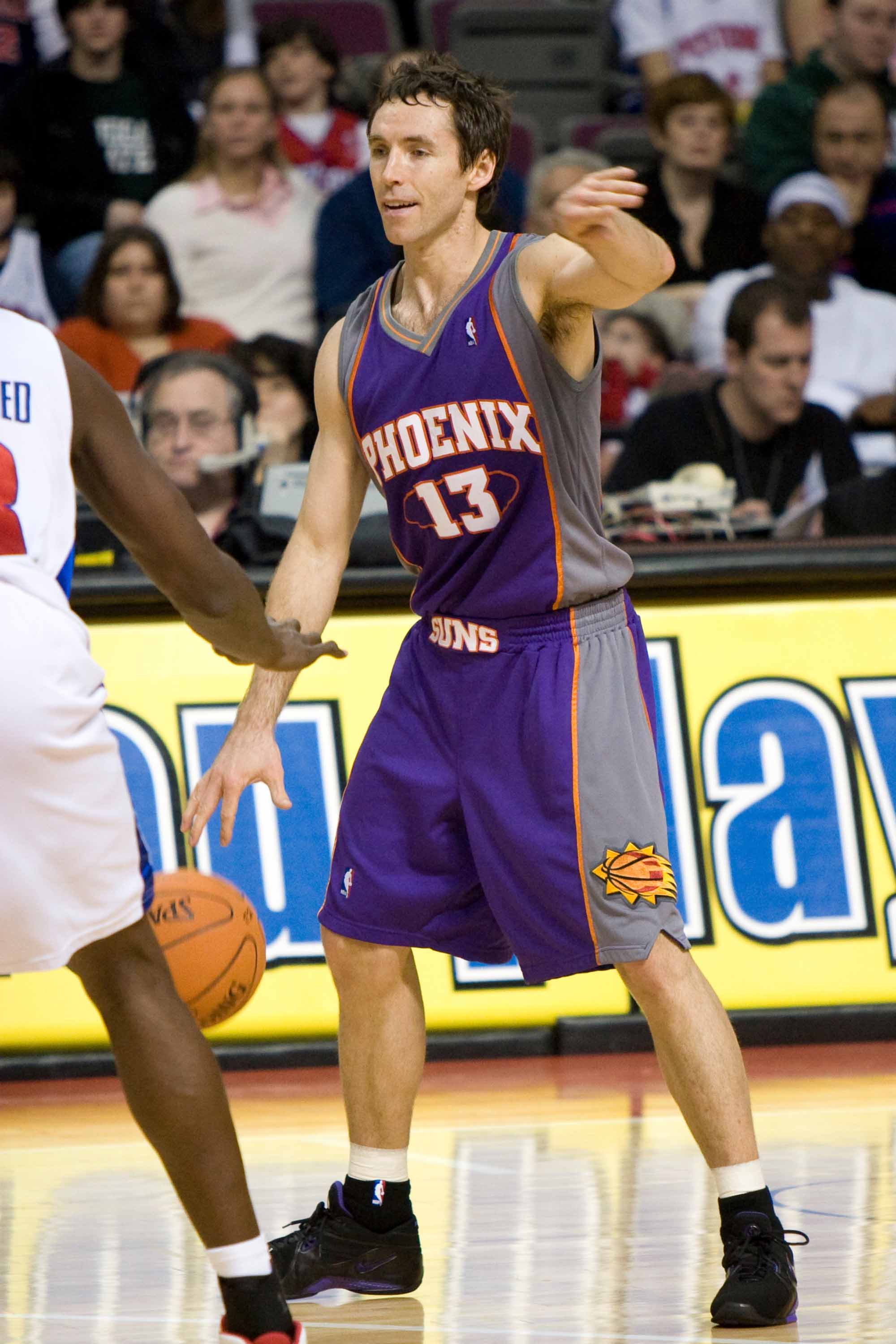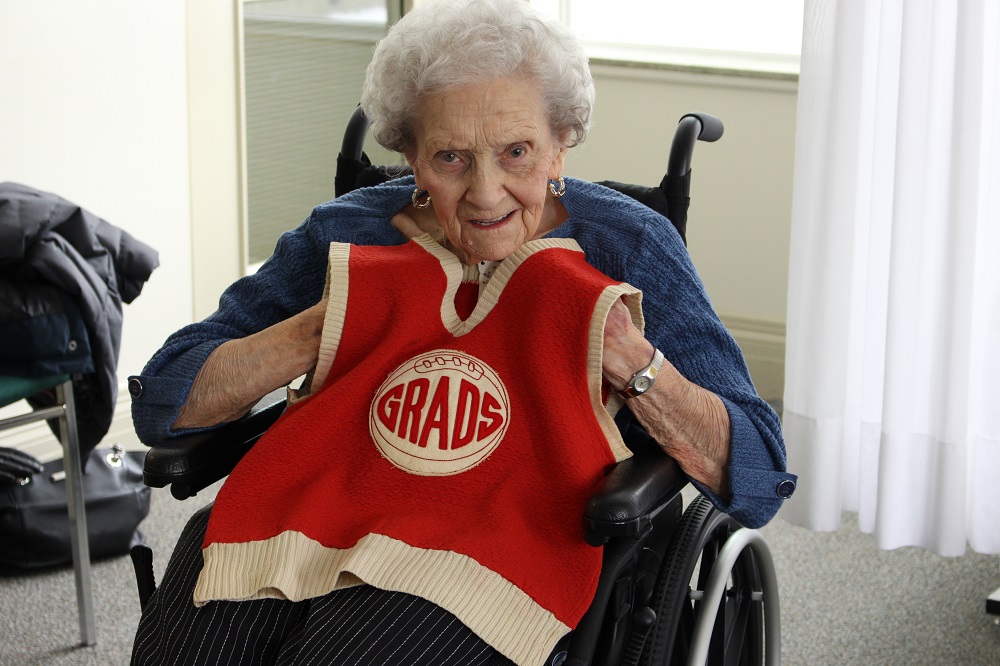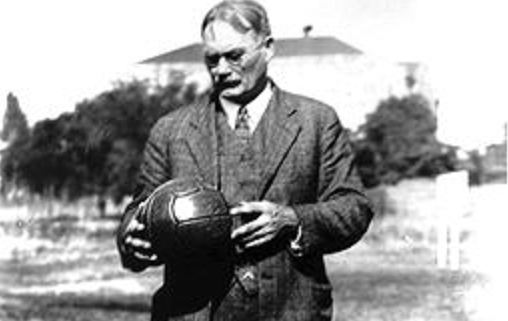Stephen John Nash, OC, OBC, basketball player (born 7 February 1974 in Johannesburg, South Africa). Steve Nash is widely considered the greatest Canadian basketball player of all time. He is a two-time National Basketball Association (NBA) Most Valuable Player (MVP) and the first Canadian to win the award. A point guard, Nash was an eight-time NBA all-star. He ranks third on the NBA’s all-time assists leaderboard with 10,335 and second in career free-throw percentage with 90.43 per cent. He represented Canada in international competition and led the Canadian Senior Men’s National Team to the quarter-finals of the 2000 Olympic Summer Games. Nash is a three-time winner of the Lionel Conacher Award as Canada’s best male athlete. He won the Lou Marsh Trophy as Canada’s top athlete in 2005. He is an Officer of the Order of Canada and has been inducted into the Order of British Columbia, Canada’s Walk of Fame, the Phoenix Suns Ring of Honour and the Naismith Memorial Basketball Hall of Fame. He was named to Canada’s Sports Hall of Fame on 27 May 2020 and will be formally inducted in 2021. He was named the head coach of the NBA’s Brooklyn Nets on 3 September 2020.

Early Life and Athletic Career
Sports and athleticism were integral parts of Steve Nash’s childhood. His father, John Nash, was a minor professional soccer player in South Africa, before the family moved to Canada in 1976. Steve’s brother, Martin, would go on to play for the Canadian National Soccer Team. Steve excelled in both high school basketball and soccer. He was named British Columbia's High School Athlete of the Year when he graduated.
Despite his accomplishments in Canadian high school basketball, Nash had difficulty breaking into the exclusive world of American university basketball. He sent more than 30 letters to American schools until finally Santa Clara University awarded him a scholarship. Nash led his new team, the Santa Clara Broncos, to several wins during his university career. The most notable came during the first round of the 1993 NCAA March Madness Tournament when the 15th-seed Broncos upset the 2nd-seed Arizona Wildcats 64–61. A freshman, Nash sunk six consecutive free throws in the final 31 seconds to seal the 64–61 win for Santa Clara. It was the first time the Broncos had made it past the first round since 1970.
Nash led his team to two more NCAA Tournament appearances in 1995 and 1996. He was named West Coast Conference Player of the Year in both seasons before declaring for the NBA draft. He graduated from Santa Clara as the school’s all-time leader in assists and. In 2006, he became the first student athlete in Santa Clara’s history to have their number retired and raised to the rafters.
Phoenix Suns (1996–98)
Nash's hopes of playing in the NBA were realized when he was drafted by the Phoenix Suns in 1996 with the 15th overall pick — the highest-ever for a Canadian at the time. Despite being a first-round pick, he spent most of his rookie season on the bench as the team’s third-string point guard. Backing up a pair of established stars at his position (Kevin Johnson and Jason Kidd), Nash averaged just 10.5 minutes per game in the 1996–97 season. His playing time increased in his second year and Nash began to establish himself as one of the NBA’s top three-point shooters. However, he only started nine games and saw his role diminish again during the playoffs.
Dallas Mavericks (1998–2004)
On 25 June 1998, Nash was given an opportunity to lead his own team when he was traded to the Dallas Mavericks in exchange for three players and a first-round draft pick. That same night, the Mavericks drafted German-born forward Dirk Nowitzki. Nash and Nowitzki would prove to be one of the NBA’s most dynamic duos. Although Nash’s scoring numbers dropped slightly in his first season in Dallas, he started all 40 games in the lockout-shortened 1998–99 season.
His breakout campaign came in the 2000–01 season. He set new career-highs in points (15.6) and assists (7.3) per game, establishing himself as one of the league’s best playmakers. With Nash, the Mavericks made the playoffs for the first time since 1990.
In 2001–02, Nash was named to the All-NBA Third Team as one of the best 15 players in the league. In February 2002, he made his first of eight appearances in an NBA all-star game. In 2002–03, Nash and the Mavericks began the season with 14 straight wins and reached the Western Conference Finals. For the second consecutive year, he was named to the All-NBA Third Team.

Phoenix Suns Return (2004–12)
Nash became a free agent in the summer of 2004. While he had planned to return to the Mavericks, he instead accepted a longer-term six-year contract with the Suns. Nash’s career soared to new heights in Phoenix. His strong shooting ability, endurance, court vision and passing instincts (honed from his early years playing soccer) made him the ideal ball-handler in head coach Mike D’Antoni’s experimental, up-tempo “Seven Seconds or Less” offence.
Less than halfway into the 2004–05 season, the Suns had already won more games than during the entire previous campaign before Nash arrived. They finished with the best record (62 wins, 20 losses) in the league. Sacrificing scoring for passing, Nash led the league in assists per game (11.5) and was named Most Valuable Player (MVP) — the first and only Canadian to earn the honour. At 15.5 points per game, Nash averaged the fewest points of any MVP since Wes Unseld in 1969.
However, Nash demonstrated his scoring ability in the playoffs. He netted a career-high 48 points during Game 4 of the Western Conference Semifinals against Dallas, his former team. Although the Suns lost that game, they won the series and reached the Western Conference Finals; they lost to the eventual champion, the San Antonio Spurs. Nash was named the Lou Marsh Trophy winner in 2005 as Canada’s top athlete — the only basketball player to have earned the honour.

The following season (2005–06), Nash again led the NBA in assists. He was named MVP for the second consecutive season — at the time just the ninth player in league history to do so. He established a career-high in points-per-game that year (18.8). He
also joined exclusive company by making at least 50 per cent of his shots (51.2%), 40 per cent of his three-point attempts (43.9%) and 90 per cent of his free-throws (a league-best 92.1%). The feat qualified Nash for the “50–40–90 Club,” a gold standard
for shooters that had only been accomplished by three other players before him. By the time he retired, Nash had made the 50–40–90 Club a record four times. Nash and Larry Bird are the only players to accomplish that feat more than once.
Apart from reaching the third round of the 2009–10 playoffs, Nash’s last five years in Phoenix were a struggle. He suffered several injuries, including recurrent problems with his back due to a degenerative form of the spinal condition, spondylolisthesis. Despite this, he only missed a handful of games and his level of play rarely faltered. In 2010, at the age of 36, he became the oldest player to lead the NBA in assists; he again had the most assists in 2011 and 2012. However, the Suns failed to reach the NBA Finals.
The Suns implemented major changes during Nash’s final seasons with the team, including the loss of D’Antoni and the addition of such notable players as Shaquille O’Neal, Grant Hill and former Toronto Raptors star Vince Carter. By 2011–12, Nash’s final season with the team, the Suns had failed to make the playoffs for two straight years. At 38 years old, Nash made his eighth and final all-star team.
Los Angeles Lakers (2012–15)
On 11 July 2012, Nash was traded to the Los Angeles Lakers in exchange for four draft picks. Nash agreed to a three-year deal with his new club. He had considered joining Canada’s only NBA team, the Toronto Raptors, but ultimately took the opportunity to play with superstar Kobe Bryant and pursue a return to the playoffs.
However, Nash’s career with the Lakers was beset by injury. In just his second game as a Laker, he suffered a fractured leg that kept him out of the lineup for nearly seven weeks. While he was sidelined, the Lakers struggled and replaced head coach Mike Brown with Mike D’Antoni, under whom Nash had achieved his greatest success in Phoenix. The Lakers made the playoffs in Nash’s first year with the team, but he suffered a hip injury that kept him out of the last eight games of the season and forced him to miss the Lakers’ two playoff games.
The following season (2013–14), Nash was diagnosed with nerve root irritation stemming from spondylolisthesis. He appeared in only 15 games that season, which would prove to be his last. On 8 April 2014, during the second quarter of a game versus the Houston Rockets, Nash registered the 10,335th assist of his career, taking the third spot on the NBA’s all-time assists list.
In October 2014, Nash announced that he would miss the entire 2014–15 season due to nerve damage in his back. In March 2015, at the age of 41, he announced that he was retiring from the NBA after 18 seasons. On 30 October 2015, the Phoenix Suns inducted Nash into the organization’s Ring of Honour.
Canadian National Basketball Team
In 1991, while he was still in high school, Nash was a standout for Team Canada on the international stage. At only 17 years old, Nash helped lead Canada to a silver medal at the 1991 World University Games. He repeated the feat two years later.
In 1999, he was named MVP at the Tournament of the Americas, when he led Canada to another silver medal, helping the Senior Men’s National Team qualify for the 2000 Summer Olympic Games (the team’s first appearance since the Seoul Olympics in 1988). Nash continued his strong play at the 2000 Olympics in Sydney, Australia. His most notable performance came during an 83–75 upset over heavily favoured Yugoslavia; Nash scored 26 points along with 8 assists and 8 rebounds. Canada reached the quarter-finals, where they lost a five-point game to France. Although disappointed by the loss, Nash saw a silver lining. “Hopefully kids will be inspired to play [in Canada],” he told reporters after the game, “That’s what I really hope.”
Nash served as the General Manager of the Senior Men’s National Team from May 2012 to March 2019.

Coaching Career
From 2015 to 2020, Nash served as a player development consultant with the Golden State Warriors. During that time, the team made four consecutive appearances in the NBA Finals and won two Championships — the first of Nash’s career. On 3 September 2020, he signed a four-year contract to be head coach of the NBA’s Brooklyn Nets. He took the helm of a contending team featuring superstars Kyrie Irving and Kevin Durant, with whom Nash developed a relationship while at Golden State.
Vancouver Whitecaps and Soccer
Nash is co-owner of Major League Soccer’s Vancouver Whitecaps FC, the professional soccer team
his brother, Martin, played on. “I grew up a Whitecaps fan,” Nash told club reporter
Farhan Devji in 2017. “I still have a picture, somewhere in my mom and dad’s house, getting Carl Valentine’s autograph… [I]t’s been a big part of our family.”
In 2016, Nash also purchased an ownership stake in Spanish soccer club RCD Mallorca.
Steve Nash Foundation
In 2001, Nash formed the Steve Nash Foundation, a children’s charity that “is committed to assisting underserved children in their health, personal development, education and enjoyment of life.” Through various programs, the foundation helps children access resources. It also supports existing charities. Nash hosts the Steve Nash Foundation Showdown, an annual celebrity soccer game in New York City that raises money for the charity.
Other Pursuits
In 2010, Nash co-directed an episode of the acclaimed ESPN documentary series 30 For 30 with his cousin Ezra Holland. The hour-long episode, titled “Into the Wind,” offers an in-depth profile of Terry Fox and his 1980 Marathon of Hope to raise money for cancer research. The documentary premiered at the Toronto International Film Festival before airing on ESPN on 28 September 2010. “I remember being a six-year-old boy and waking up every morning and rushing to the TV to see where Terry was that day,” Nash said at the time, describing Fox as his personal hero. “To see his face hiding the pain and to hear his words disguising the sacrifice was as motivating and as educational an experience as I’ve ever had.” (See also: Terry Fox: Role Model and Inspiration; Editorial: The Courage of Terry Fox.)
Family
Nash was married to Alejandra Amarilla from 2005 to 2011. The couple has three children together: twin daughters, Lola and Isabella, and a son, Matteo. In 2016, he married former volleyball player Lilla Frederick; their son Luca was born in 2017.
Induction into Basketball Hall of Fame
In September 2018, Nash was inducted into the Naismith Memorial Basketball Hall of Fame. Nash delivered a 20-minute speech during the ceremony, thanking his family, coaches and teammates. “I was never, ever supposed to be here,” he remarked. “I was an underdog, I scraped and clawed my way into college, I did the same in the NBA. I just never stopped.” He closed with the following advice for the next generation:
Find something you love to do, do it every day. Be obsessed — balance can come later. Use your imagination. Put pen to paper. Declare your intentions. Set small goals. Knock them off, set more goals. Gain momentum, build confidence. Grow a deep belief. Outwork people. Play the long game. You don’t have to be the chosen one. The secret is to build the resolve and the spirit to enjoy the plateaus, the times when you don’t feel like you’re improving and you’re questioning why you’re doing this. If you’re patient, the plateaus will become springboards. Finally, never stop striving, reaching for your goals until you get there. But the truth is, even when you get there, even when you get here, standing on this stage, it’s the striving, fighting, pushing yourself to the limit every day that you’ll miss and that you’ll long for. You’ll never be more alive than when you give something everything you have.
Nash is the second Canadian-born player to be inducted into the Naismith Memorial Basketball Hall of Fame. Bob Houbregs (born in Vancouver in 1932) was enshrined in the Hall in 1987.
Honours and Awards
- Tournament of the Americas MVP (1999, 2003)
- Queen Elizabeth II Golden Jubilee Medal (2002)
- NBA All-Star (2002, 2003, 2005–08, 2010, 2012)
- Lionel Conacher Award (2002, 2005, 2006)
- NBA Most Valuable Player (2005, 2006)
- Lou Marsh Trophy (2005)
- NBA assists leader (2005–07, 2010–11)
- Order of British Columbia (2006)
- Officer, Order of Canada (2007)
- NBA Walter Kennedy Citizenship Award (2007)
- Honorary Doctor of Laws, University of Victoria (2009)
- Queen Elizabeth II Diamond Jubilee Medal (2012)
- Phoenix Suns Ring of Honour (2015)
- Naismith Memorial Basketball Hall of Fame (2018)
- Canada’s Sports Hall of Fame (2021)

 Share on Facebook
Share on Facebook Share on X
Share on X Share by Email
Share by Email Share on Google Classroom
Share on Google Classroom


